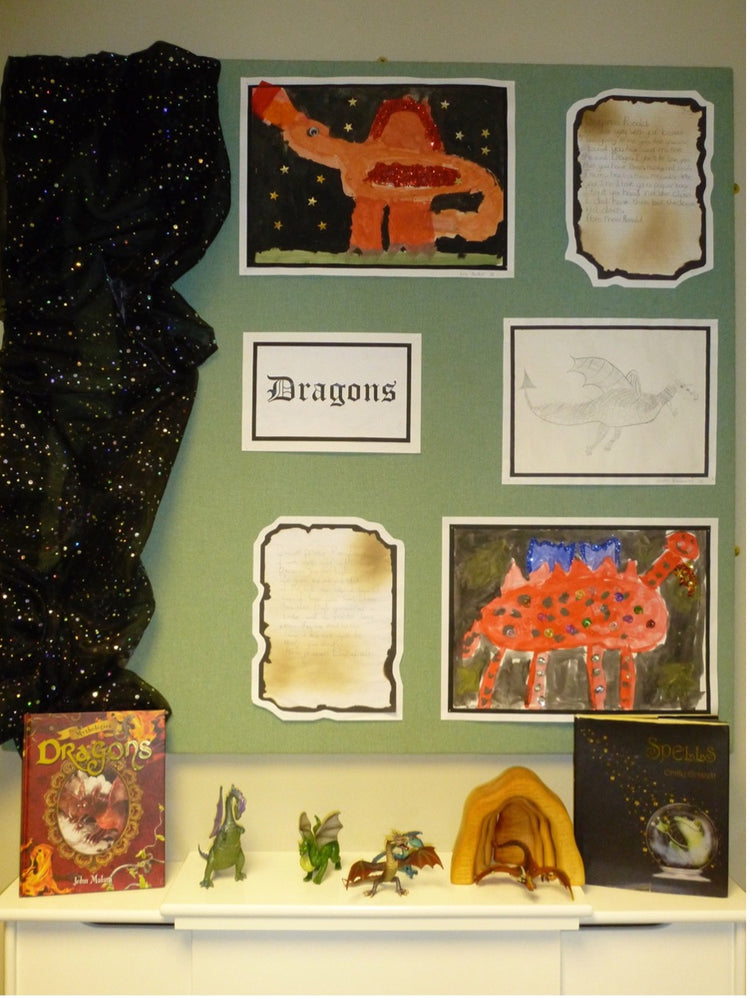I suppose I am very old fashioned about displaying children’s work. When I was at college, at good ole’ Bishop Grot, we had workshops on triple mounting, they measured our drapes to make sure each pleat was exactly 2 inches wide and we were even given calligraphy lessons. These days teachers are not to ‘waste time’ on such things, but I fear too many classrooms look shoddy and unkempt and although this is sometimes more to do with peripheral clutter, I think displays could be a lot better. And it’s not just about looks.
To my mind, children’s work – especially that which has been done in provision from their own original thinking – should be cherished and celebrated. Children should be rewarded handsomely for effort, and we should celebrate their try, their growing skills, their delightful ways of seeing the world. Surely the classroom should be a reflection and celebration of their thinking and doing, rather than a set of corporate must have displays they can’t even read?

In many schools, once you include the birthday display*, the British Values Display, Behaviour Display, Books we are reading this year display as well as the Literacy and Maths working boards, there might be a board left for topic and in the odd classroom here and there, I see a ‘wow’ board, which looks anything but. This tends to be in a free-for-all sort of design with children’s work stuck up at ‘jaunty angles’ with a pin, unmounted, not annotated, not particularly visible in the sea of work that has been up since September.
Where are the boards that celebrate what children bring to the learning table? Where are the boards that say to the child: you are a stakeholder in your learning journey? Where are the displays that celebrate children’s own thoughts, discoveries, experiments, ways of seeing the world, interests, needs and skills from their independent work in provision? If these boards are absent from your classroom, then what’s the message?
*Birthday Displays: free up a board by putting your display into a book and put it in the reading area where children can handle it, find their name and date, and talk with their friends about their aspirations for their special day. On a board, it’s just wallpaper, anyway!
These are my personal rules for putting up displays:
- The background should not detract from the children’s work. That’s why some schools say they have been ‘Jacobed’ when they redecorate in soft green and put hessian up on every board: it offers a soft, natural background for children’s work to stand out. If you are still doing acid yellow backing paper with a leopard print wavy border, please re-consider: The children’s work, or photographs of their activities should be the thing that draws your eye, not the clashing wavy border!
- The work should be mounted. I would double mount most things in black and white; it depends what makes the picture look good.

- Try to leave a border around the edge of your display and make the spaces between the work as even as possible.

- Make your display about one thing, don’t clutter it up with several displays in one, like this monstrocity!

This makes me want to scream. If I was dyslexic, autistic or dyspraxic, it would make me feel sick. There is far too much work, too many bright colours vying for attention. What are we supposed to be looking at?
- Try to mix the media: paintings, drawings, chalk or oil pastel work, computer generated art, writing, clay work or box models.

I am sorry that it is not a very clear picture, but hopefully you can see that the title would be easy to read without it taking up half the board.
- Don’t put children’s work up at a ‘jaunty angle’ unless they created it that way.
- Don’t cut out or around children’s work. Please steer as clear from the, ‘class frieze’ as you can – this is craft-by-adults, not artwork by children and please don’t ever give a child something to draw around, such as a template or something to colour in. This is despicable practice – it tells the child, ‘Your attempt will be disastrous, so use this and your effort will look something like it’s supposed to be. Firstly, in children’s artwork, there is no ‘supposed to be.’ Secondly, we must NEVER do anything to undermine a child’s creative confidence and thirdly, it tells us nothing. We are not interested in your drawing or photocopying ability.
- The younger the child, the larger the piece of paper. A4 printing paper is NOT fit for purpose when it comes to painting or collage. Circles pop and bring a fantastic element to any display.
- If the children spend 40% of their time learning outside, should evidence of the work they do out there be represented by the same percentage?
- Is a 5-year-old half of a 10-year-old? No? Then why does an Early Years classroom have to have the same types of displays as a Year 5 classroom? Please don’t answer this by arguing ‘policy’ by SLT or academy – go and argue with them!
Gridded ‘displays’ full of individual children’s work are open work files, not display in old fashioned terms and I think they generally look messy and the work uncared for. Privacy is also a bit of an issue for me: as a parent I would be happy with this system if my child was keeping up, but not so much if it showed my child clearly a long way behind the rest. As for parents who love to compare…. I know you might conclude that the same can be said for any display, but we tend to choose something very special and unique from each child when we make a display of work of their special work.
Knowing that children tend to repeat what they are given any attention for, displays that celebrate children’s work need to reward effort and original thinking. Display affects culture in a huge way. Does the culture of your classroom say, ‘I value the hard work and effort you put into your paintings, clay work, sewing, collage, and drawing? Does it show that you think the work children produce on their own in provision is extremely important and, “ I am going to give it at least as much credence as the work you do with me” ?

Displays can be used well for all sorts of other reasons, such as provocations, information, to generate or show children working through questions. A display of beautifully presented items to be used in play can bring organisation, ordering, inspiration and planning to children’s thinking.

A display might be completely managed by children to show others their work and thinking.

Some displays can be useful as a way of helping children to remember processes, ways of tackling problems, or reminders about skills, information and expectations.

However, please do not make working walls part of an Early Years classroom. They are entirely inappropriate and out of sync with Early Years philosophy!

Displays used as a reminder that to think outside the box are a great thing!

Whatever you use display for, think about what it is achieving, make sure you draw children’s attention to it, so they know what it says and why it is there, and think about the message it is giving.


